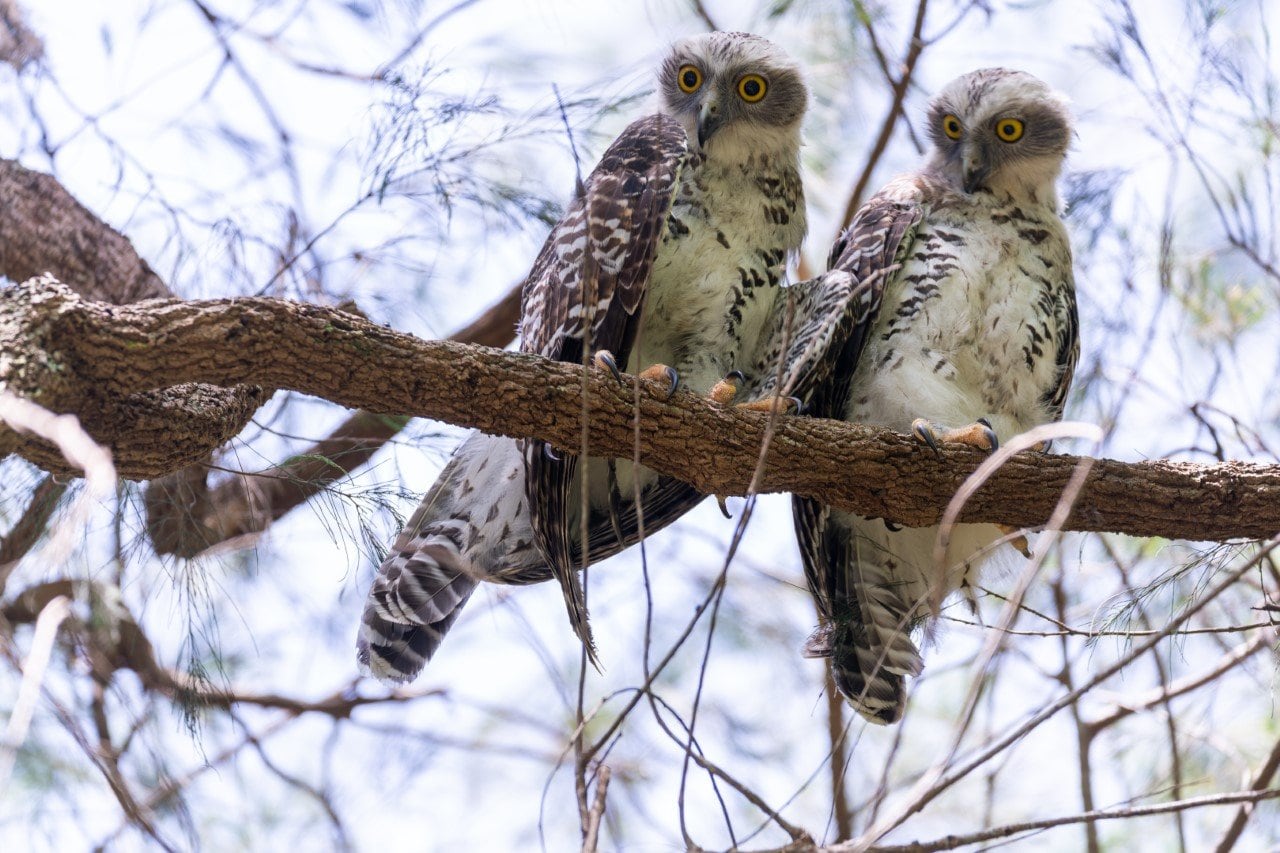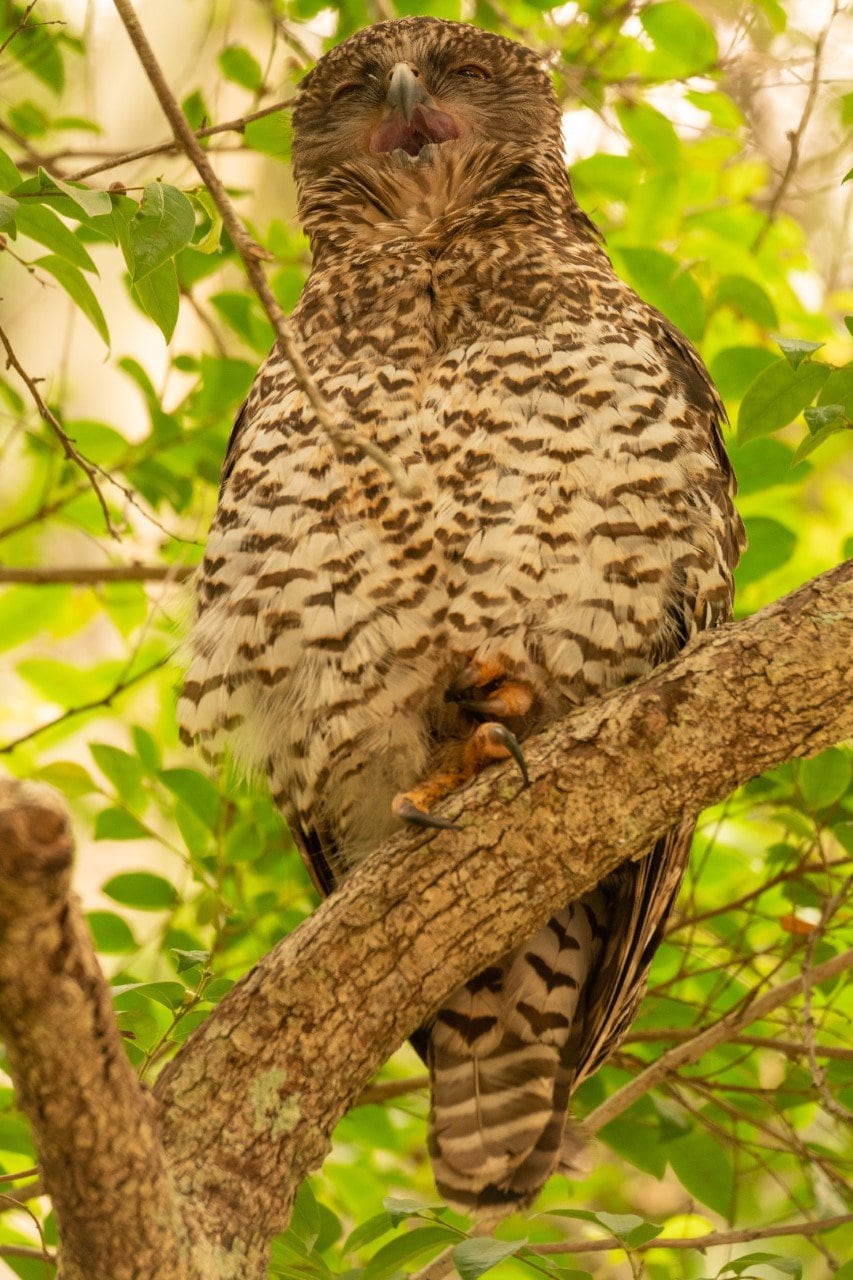Powerful owl takes a bath: see the video

Our place was built 100 years ago in a gully next to a small spring fed stream that cascades down a hill. There are waterfalls and small pools, it’s cool and moist and protected from most winds.
The backyard adjoins a pocket reserve with tall spotted gums and remnants of littoral rainforest. It’s a small green space and part of a wildlife corridor with habitat for species like sugar gliders, ringtail and brushtail possums, micro bats, bandicoots, brush turkeys and many birds.
There is a grey gum on the edge of the reserve with a hollow, it has been a successful breeding tree for a pair of vulnerable powerful owls. I’ve watched 4 breeding seasons, the young owls roost in our backyard, it’s safe and quiet and they stay here for up to 6 months while they grow up.

In 2019 the pair had two owlets, they fledged together and were inseparable. I saw them drinking from the creek in the early hours, I noticed their wet feathers and started watching them at dawn, they were having a bath in the creek before roosting for the day. I soon realised how dependant they were on the stream.
As the drought continued the water began to dry up until there was only a small shallow pool left. Spring was turning to summer and I feared that soon the stream would dry up. As the smoke began, I had to accept we may be facing a summer without water, so I started searching for a bird bath.
I knew that it had to be big and solid to support these birds with a 1.4m wing span. Eventually, I found one in a large koi pond that was being demolished. It was made of concrete and river stone, with a 1m diameter, 25cm deep and a capacity of about 100L, it had a solid lip of 6cm that the owls could grasp on to. It was heavy and it needed four people to carry it up the stairs to the back of the house.
When I looked for a position, I knew that the owls would only use it if they could fly in easily and have a quick escape as well. I set it underneath a large cheese tree near our back door and used a fallen spotted gum branch to make a perch between 2 trees about 15m away. This perch would allow them fly in and check out the bird bath first.
To my surprise the owls took to it almost immediately, in the twilight of dawn we heard the excited calls of the young owls, when we had a look, they were staring at their reflections in the water and then we watched in amazement as they climbed in and had a swim, they stayed at the bird bath for over half an hour.
We kept the water clean and fresh and this soon became a daily ritual, at dawn we would hear the owls calling as they came home to roost, the big male would go in for a swim first, climbing down into the middle and standing on the bottom, he would wash his face and get himself thoroughly wet. The female would follow and then the youngsters, one morning all four of them were drinking out of the bird bath at the same time.
Owls have 3 eyelids and they find it irritating when the smoke is bad, you can watch them washing their eyes out. They struggle in the heat and their instincts stop them from coming down for a drink on hot days, this is why owls don’t survive well in bushfires. They suffer in the trees panting and stressed, and don’t come down to the water until dusk.
On one particularly hot and smoke-filled day in December the male roosted in the cheese tree directly above the bird bath, we spent the day tiptoeing around the house so we wouldn’t disturb him. By this stage the stream was completely dry, and he was roosting directly over the only bit of water left. At sunset he was in the bird bath.

Without the bird bath the family would have abandoned their roost, it allowed the young owls to stay while they grew up. The stream is now flowing again, and last year’s owlets have moved on. It’s been a terrible year for threatened powerful owls and our pair have had a bad time. They have had to cope with illegal land clearing around our reserve, one incident spooked them from the nest tree and their young owlets were taken by cockatoos.
Hopefully they will breed again next year, however the small reserve they call home (like many other similar reserves), is in danger, too many trees have gone in a lusting for views, affecting all the species that rely on the reserve. I have spent the year trying to regenerate and have planted hundreds of trees, to the sound of chainsaws around me.
The pair still come and drink from the bird bath, and when the temperature is above 20 degrees, they like to go night swimming. It is also a success with the kookaburras, cockatoos and lorikeets, all the animals and birds drink out of it, including the possums, it brings us other surprises too, like the day we delighted in watching a buff banded rail happily having a swim.
To hear firsthand from Andrew about the owls, listen to him on our Talking Australia podcast.
Follow Andrew and the owls on his Instagram account @andrewgregoryphotographer

